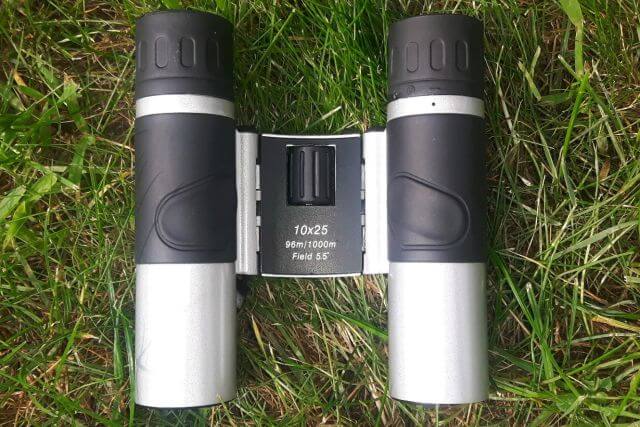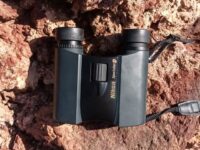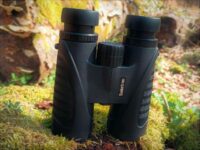This post contains affiliate links. If you follow a link I may earn a small commission at no extra cost for you.
Bresser is a German manufacturer of optical instruments. The products include astronomical telescopes, microscopes, binoculars, and optical accessories. The company was founded by Josef Bresser in 1957. Their principle of “Top quality at a fair price”, has made BRESSER one of the world’s leading suppliers of binoculars and optical products. Bresser offers a very extensive range of products, which includes inexpensive binoculars for occasional nature observation as well as high-quality optics for the hunter and ambitious bird watcher. Reliability, functionality, and high quality at a low price apply to all products.
Bresser Topas 10×25 Pocket Binoculars
The Bresser Topas 10×25 are small, super affordable, compact binoculars that are simply practical and may come in handy if you have to take a closer look at something distant.
Specs of the Bresser Topas 10×25 Pocket Binoculars
| Optical Glass | Standard Crown |
| Lens Coating | Fully coated |
| Prism systems | BK7 |
| Magnification | 10x |
| Objective diameter | 25 mm |
| Exit pupil | 2.5 mm |
| Eye relief | 12 mm( est) |
| Field of view | 96m/1000m 288ft/1000yrd |
| Close focus | 16 feet 5 meter |
| Twilight factor | 15.81 |
| Water resistance | Water-resistant |
| Weight | 6.7 oz/ 190 gr |
First general impression
At first glance, the Bresser Topas 10×25 binoculars look quite solid, the instrument is neat and well-made, and everything fits together well. The compact binoculars have a solid aluminum housing that is equipped with non-slip rubber armoring for a good grip. When folded, the binoculars are really tiny and with the low weight of only 6 ounces, the Bresser Topas 10×25 proves to be a very light and handy companion that really finds its place in every bag or backpack. But how good are the optics and the performance?
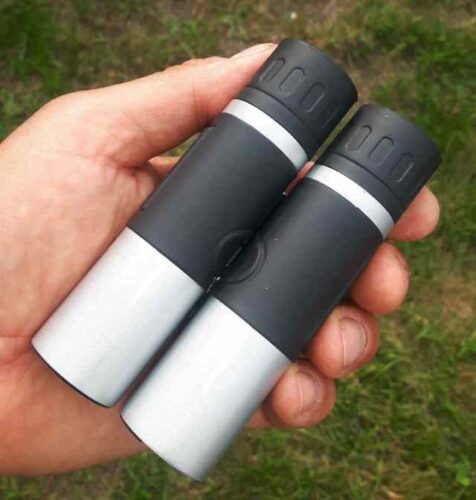
Mechanics
The wide middle bridge and the hinges are made of aluminum, which is robust and can withstand a fall without collimation suffering. The moves smoothly and evenly man hinges allow you to adjust the interpupillary distance precisely.
The eyecups aren’t particularly adorable. They are just fold-out rubber extensions of the eyepiece tube with a length of about 3/16 inches. However, they are made of soft rubber and can be folded down so that the eye can get a little closer to the exit pupil if necessary. But the eye relief is only 10 mm, which is very little overall and it is questionable whether a person who wears glasses will benefit much from that. There is a diopter compensation on the right eyepiece.
Focus Wheel
The center focus is sufficiently large, it is ergonomically placed and easy to use with the outstretched index finger. It rotates smoothly and evenly and allows effortless and precise focusing.
The optics
10x magnification as well as 8x is a good choice for compact binoculars, more e.g. 12×25 will be a bit more difficult to hold steady during longer observations. This is due to the low weight and high magnification. The disadvantage of being too light results in less inertia of its own. But a little more inertia would dampen slight wobbling movements while watching. However, this small instrument is only intended for short observations and not for extensive wildlife or birdwatching, so it’s no big deal.
The objective diameter of 25mm in combination with 10-fold magnification results in an exit pupil of 2.5 mm. This is quite sufficient in bright daylight, in twilight the performance is weak, and at night the instrument is of not much use.
Lens Coating
The fully multi-coated optics improve contrast and increase light transmission to be able to see well even in dull light conditions. However, the exit pupil is quite small, so the use in weak light is only limited. If you hold the binoculars with the lens into the light you can see the blue lens coating quite well.
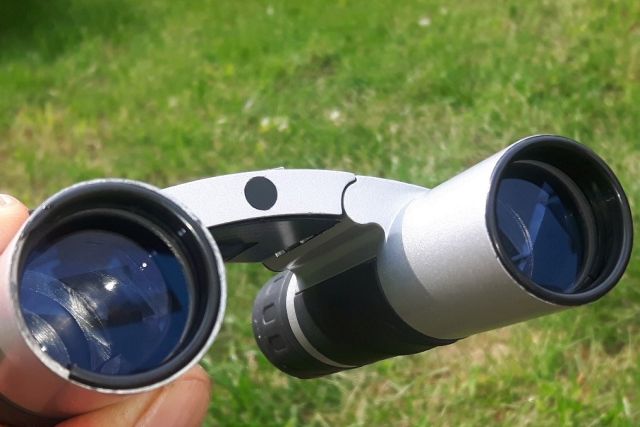
When holding the Topas with outstretched arms into the light the exit pupil appears round. The manufacturer describes the prisms made of BK7 glass. But they seem to be well-dimensioned, as they hardly appear rectangular.
Eye Relief
I can’t find any specific data for eye relief anywhere. I tried to measure the eye relief, and I got around 12mm. My daughter, who wears glasses, was not enthusiastic about using them, but it was ok with the diopter compensation.
Close Focus
The topaz can be used from a distance of approximately. 12 feet and more, the images appear sharp and rich in contrast. Anything closer than about 12 feet cannot be focused on.
Collimation
With the binoculars I used, the optical axes were aligned parallel and no double images could be observed. The sturdy middle bridge made of aluminum should assure this even with rough use or when accidentally dropped.
Edge sharpness and Edge Blurring
In such inexpensive binoculars, you have to expect aberration. However, the central 50 percent of the images viewed appear well focused, but further towards the edge, the edge blurring increases significantly.
Chromatic Aberration / Color Fringing
Chromatic aberration cannot be avoided in cheap binoculars. To reduce these requires high-quality optical glass and a sophisticated lens system. With uniformly bright objects, the color fringes are quite faint, but with increasing strong light-dark contrast, color fringing also increases.
Color fidelity
When using the binoculars, one notices that the observed objects appear true to color with a little tendency towards blue.
Pros
- Good value
- Multi-coated lenses and prisms
- The focusing wheel works smoothly and allows precise adjustment
- Diopter compensation
- Comes with a carry case in which the binoculars can be stowed, a neck strap, and a cleaning cloth.
Cons
- Not for use in low-light conditions
- Low weight + strong magnification = shaky observation
- Fastening clips of the neck strap get in the way when using the binocular without the neck strap
Conclusion
The very affordable Bresser Topas 10×25 shows no major flaws. The aluminum-made chassis, middle bridge and hinges of the Bresser Topas 10×25 seem robust and sturdy. Focusing is easy and precise, there is slight edge blurring which is to be expected at such a low price. During daylight viewing the instrument performs well, as for the twilight performance, at dawn in low light the image brightness decreases noticeably.
The Topas is a good choice if you are looking for a small, robust binocular for occasional use. This instrument is unsuitable for expert users or serious wildlife and bird-watching excursions.
More info:
The Bresser Topas 10×25 is currently no longer available and will be replaced by the successor model, the BRESSER Hunter 10×25 Pocket Binoculars.
bresser.de/en/Sport-Optics….Hunter-10×25-Pocket-Binoculars.html
